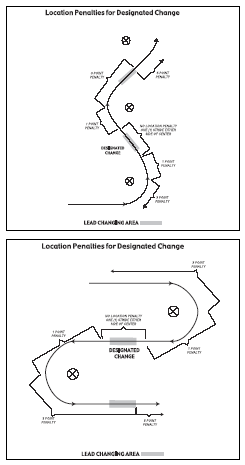
453. WESTERN RIDING
(a)
Western Riding is an event where the horse is judged onquality of gaits, lead changes at the lope, response to the rider, manners,
and disposition. The horse should perform with reasonable
speed, and be sensible, well-mannered, free and easy moving.
(b)
Credit shall be given for and emphasis placed on smoothness,even cadence of gaits (i.e., starting and finishing pattern with the same
cadence), and the horse’s ability to change leads precisely, easily, and
simultaneously both hind and front at the center point between markers.
In order to have balance, with quality lead changes, the horse’s
head and neck should be in a relaxed, natural position, with his poll
level with or slightly above the level of the withers. He should not
carry his head behind the vertical, giving the appearance of
intimidation, or be excessively nosed out, giving a resistant
appearance.
The horse should have a relaxed head carriageshowing response to the rider’s hands, with a moderate flexion at the
poll. Horses may be ridden with light contact or on a reasonably loose
rein. (Refer to 463a) The horse should cross the log both at the jog
and the lope without breaking gait or radically changing stride.
(c)
The judge will select one of the four patterns to be performed.The judge is responsible for the pattern being correctly set.
(d)
On the pattern:(1)
The eight small circles represent pylon markers whichare recommended. These should be separated by a uniform measured
distance of not less than 30 feet (9 meters) nor more than 50 feet (15
meters) on the sides with 5 markers (see diagram). In pattern one,
the three markers on the opposite side should be set adjacent to the
appropriate markers. It is recommended that markers be set a minimum
of 15 feet (4 1/2 meters) from the fence and with 50 to 80 foot
(15 to 24 meters) width in the pattern, as the arena permits.
(2)
A solid log or pole should be used and be a minimumof 8 feet (2.5 meters) in length.
(3)
The long serpentine line indicates the direction of traveland gaits at which the horse is to move. The shaded area represents
the lead changing area between the markers. The dotted line (...)
indicates walk, the dash line (- - -) jog, and the solid line ( - ) lope.
(e)
Scoring will be on a basis of 0-100 with 70 denoting anaverage performance.
(1)
Scoring guidelines to be considered: points will beadded or subtracted from the maneuvers on the following basis, ranging
from plus 1.5 to minus 1.5: -1.5 extremely poor, -1 very poor, -
.5 poor, 0 average, +.5 good, +1 very good, +1.5 excellent. Maneuver
scores are to be determined independently of penalty points.
(f)
A contestant shall be penalized each time the following occur:Five (5) points
(1)
Out of lead beyond the next designated change area(note: failures to change, including cross-cantering. Two consecutive
failures to change would result in two five (5) point penalties).
(2)
blatant disobedience including kicking out, biting,bucking, and rearing
Three (3) points
(1)
not performing the specific gait (jog or lope) or not stoppingwhen called for in the pattern, within 10 feet (3 meters) of the designated area
(2)
simple change of leads(3)
out of lead at or before the marker prior to the designated changearea or out of lead at or after the marker after the designated change area
(4)
additional lead changes anywhere in pattern (exceptwhen correcting an extra change or incorrect lead)
(5)
in pattern one and three failure to start the lope within30 feet (9 meters) after crossing the log at the jog
(6)
break of gait at walk or jog for more than two strides(7)
break of gait at the lopeOne (1) point
(1)
hitting or rolling log(2)
out of lead more than one stride either side of thecenter point and between the markers
(3)
splitting the log (log between the two front or two hind feet) at the lope(4)
break of gait at the walk or jog up to two (2) stridesOne-half (1/2) point
(1)
tick or light touch of log(2)
hind legs skipping or coming together during lead change(3)
non-simultaneous lead change (Front to hind or hind to front)Disqualified - 0 score
(1)
illegal equipment(2)
willful abuse(3)
off course(4)
knocking over markers(5)
completely missing log(6)
major refusal - stop and back more than 2 strides or 4steps with front legs
(7)
major disobedience or schooling(8)
failure to start lope prior to end cone in patterns #1 and #3(9)
four or more simple lead changes and/or failures to change leads(10)
overturn of more than 1/4 turn(11)
Faults, which will be cause for disqualification,except in novice amateur or novice youth classes, which shall be
faults, scored according to severity:
(A)
Head carried too low (tip of ear below withers consistently)(B)
Over flexing or straining neck in head carriage sothe nose is carried behind the vertical
consistently.Credits
(1)
changes of leads, hind and front simultaneously(2)
change of lead near the center point of the lead change area(3)
accurate and smooth pattern(4)
even pace throughout(5)
easy to guide and control with rein and leg(6)
manners and disposition(7)
conformation and fitness(g)
The following characteristics are considered faults andshould be judged accordingly in maneuver scores
(1)
opening mouth excessively(2)
anticipating signals(3)
stumbling(4)
head carried too high(5)
head carried too low (tip of ear below the withers)(6)
over-flexing or straining neck in head carriage so thenose is carried behind the vertical
(7)
excessive nosing out
WESTERN RIDING PATTERN I
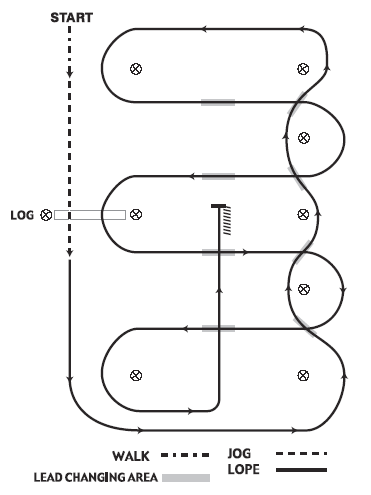
1. Walk at least 15’ & jog over log
2. Transition to left lead & lope around end
3. First line change
4. Second line change
5. Third line change
6. Fourth line change lope around the end of arena
7. First crossing change
8. Second crossing change
9. Lope over log
10. Third crossing change
11. Fourth crossing change
12. Lope up the center, stop & back
WESTERN RIDING PATTERN II
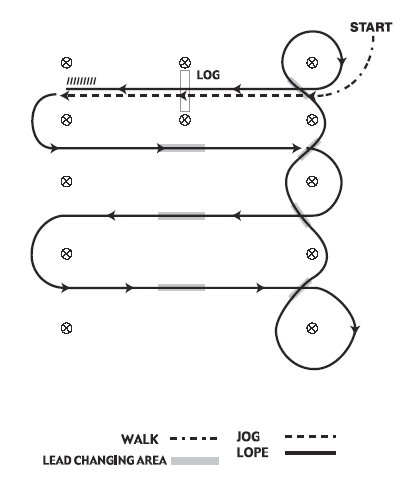
1. Walk, transition to jog, jog over log
2. Transition to the lope, on the left lead
3. First crossing change
4. Second crossing change
5. Third crossing change
6. Circle & first line change
7. Second line change
8. Third line change
9. Fourth line change & circle
10. Lope over log
11. Lope, stop & back
WESTERN RIDING PATTERN III
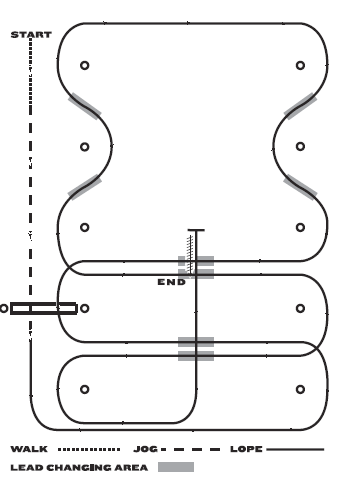
1. Walk halfway between markers, transition to jog,
jog over log
2. Transition to the lope, on the left lead
3. First crossing change
4. Lope over log
5. Second crossing change
6. First line change
7. Second Line change
8. Third line change
9. Fourth line change
10. Third crossing change
11. Fourth crossing change
12. Lope up the center, stop & back
WESTERN RIDING PATTERN IV
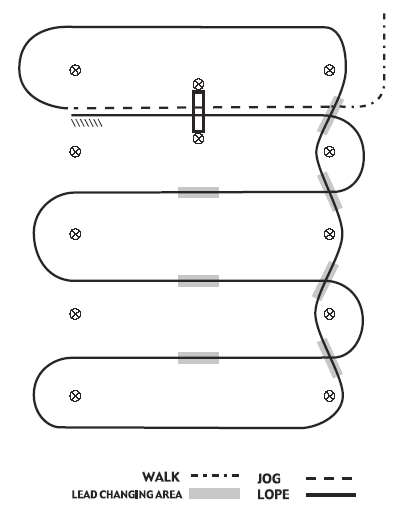
1. Walk, transition to jog, jog over log
2. Transition to the lope, on the right lead
3. First line change
4. Second line change
5. Third line change
6. Fourth line change
7. First crossing change
8. Second crossing change
9. Third crossing change
10. Lope over log
11. Lope, Stop & back